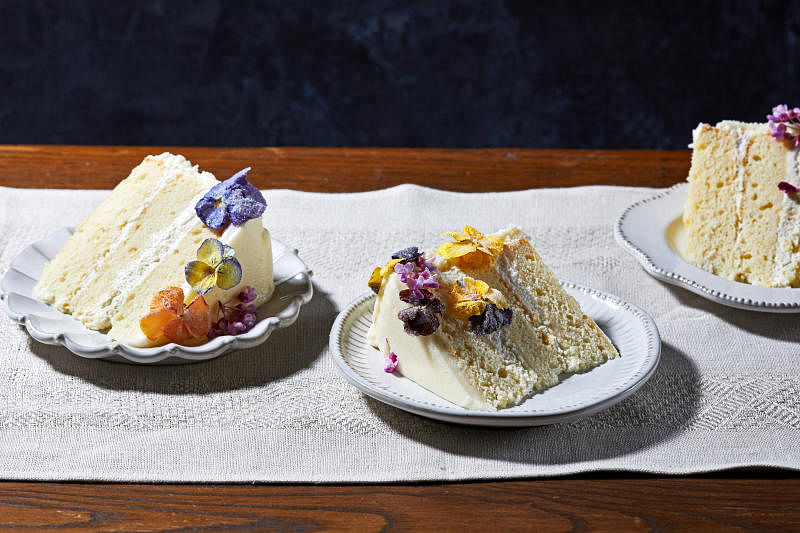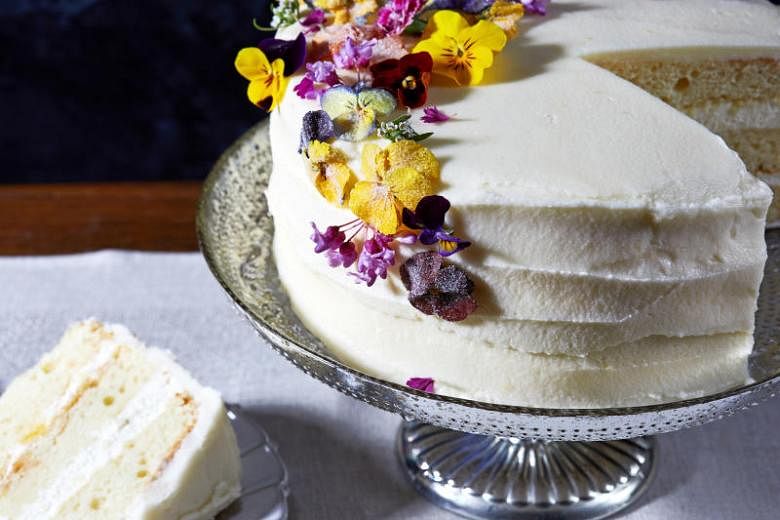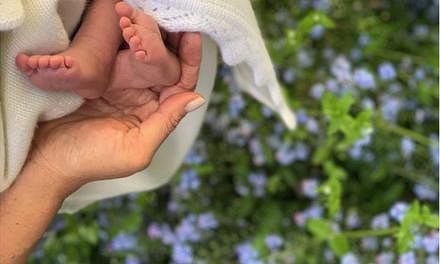(THE WASHINGTON POST) - Birthday, wedding, baby shower, ordinary Tuesday night. . . No matter what you're celebrating, a layer cake is always a good idea.
No dessert has received more attention lately than the cake that will be on display at the May 19 wedding of Prince Harry and Meghan Markle. All we know is American expat Claire Ptak, owner of Violet bakery in London, is making a lemon elderflower cake that will be decorated with buttercream and fresh flowers.
I smelled a challenge. Could I come up with my own version of the royal wedding cake for us commoners?
Using recipes that I adapted from Ptak's 2015 cookbook, the answer was a resounding yes. Even better, I adjusted the elements to create a layer cake even less-experienced bakers could conquer. Sometimes, a celebration calls for a little extra effort.
One adjustment I made for my own sanity was baking three thin cake layers rather than the tall single cake Ptak says to make in a 3-inch (7.6cm) deep pan. First of all, I don't own one of those, and second, I've never been good at slicing cakes evenly. Bonus: Thin cakes bake and cool faster.
You could certainly make the cake and the frosting - a simple confectioners' sugar and butter combination - put them together and call it a day. If you don't own one, a small offset spatula will earn its very cheap price for frosting and filling this cake, not to mention many other kitchen tasks.
For an amped-up filling, use lemon curd (homemade, if you're up for it) instead of frosting. Or go up one more level by mixing it with whipped cream.
You can decorate this cake as much or as little as you want. A pristine white cake is timeless. No fancy cake tools? Grab a spoon and spin a swirl into the top, or cut the corner of a food-safe zip-top bag to pipe dollops around the edge. Use store-bought candied lemon slices or peel for added pizazz.
In the spirit of the actual royal wedding cake, I decorated this version with edible flowers. Be sure you source flowers that have been specifically grown for culinary use. You can also sometimes find them in the produce section of grocery stores. I crystallised some of the flowers and combined them with other fresh ones, gently pressing both types into the top and then in a cascade down the side of the cake. If you just want to use fresh flowers, that would be lovely, too.
A note on ingredients: I found Belvoir Fruit Farms elderflower cordial (non-alcoholic), used for brushing the cake layers, at World Market. It can also be ordered from various sites online. (The brand's products are carried at stores such as Whole Foods, Mom's and Fresh Market.) Ikea sells an elderflower syrup as well. For additional elderflower flavour in the cake and frosting, I used St-Germain liqueur, but you can leave it out or use the cordial instead.
The baked, cooled cake layers that have been brushed with cordial can be refrigerated, well-wrapped, for several days or frozen for up to several weeks.
You can refrigerate the buttercream several days in advance, too. Smooth out the chilled frosting with a stir by hand or mixer. The frosted and decorated cake can be refrigerated overnight in a cake caddy, under a cake dome or very loosely tented with plastic wrap.
Royal Wedding Cake

16 servings
INGREDIENTS
For the cake
8 Tbs (1 stick) unsalted butter, at room temperature, plus more for the pans
1 cup granulated sugar
1 Tbs finely grated lemon zest (from 1 lemon; reserve the juice for the frosting)
3 large eggs, at room temperature
1 tsp vanilla extract
1/2 tsp salt
2 cups flour
2 tsps baking powder
1 tsp St-Germain or other elderflower liqueur (optional)
2/3 cup whole milk
1/2 cup elderflower cordial, plus more as needed
For the filling
1 cup chilled heavy whipping cream
1/2 cup homemade or store-bought lemon curd, at room temperature
For the frosting
14 Tbs (1 3/4 sticks) unsalted butter, at room temperature
4 to 5 cups confectioners' sugar, or more as needed
7 Tbs whole milk
1/2 tsp finely grated lemon zest and 2 Tbs juice (from 1 lemon)
1 Tbs St-Germain or other elderflower liqueur (optional)
For assembly
Fresh or crystallised flowers, or a mix (optional; see related recipe)
METHOD
1. For the cake: Preheat the oven to 150 degrees Celsius. Use a little butter or baker's spray to grease three 20cm cake pans and line the bottoms with parchment paper rounds. (If you only have one or two pans, cover the batter that's waiting to be baked; hold at room temperature. Make sure the cake pans are cool before you reuse them, which is pretty easily done with a wash in cool water in the sink.)
2. Place the granulated sugar in the bowl of a stand mixer or handheld electric mixer. Use your clean fingers to rub the lemon zest into the sugar until the sugar is aromatic and moist.
3. Add the butter; beat on medium-high speed for about 3 minutes, or until the mixture is fluffy and light.
4. Meanwhile, lightly whisk together the eggs, vanilla extract and salt in a liquid measuring cup.
5. Reduce the mixer speed to low; gradually add to the butter-sugar mixture until fully incorporated. Stop to scrape down the bowl.
6. Whisk together the flour and baking powder in a separate bowl, then add half of it to the butter mixture. Beat on low speed until just combined, then add the milk and the elderflower liqueur, if using. Beat on low speed, until well incorporated.
7. Add the remaining flour; beat on low speed until no trace of dry flour remains. Divide equally among the cake pans and smooth the tops with an offset or flexible spatula. (If you use a kitchen scale, each portion of batter should weigh about 300 grams.)
8. Bake (middle rack) for 15 to 20 minutes, until the top of each cake layer springs back to the touch. The edges will be very lightly browned and starting to pull away from the sides of the pans.
9. Cool in the pans for 15 minutes, then run a round-edged knife or offset spatula around the inside of the pans to release the layers. Invert onto a wire rack and peel off the parchment paper. Use a pastry brush or silicone brush to apply the elderflower cordial a total of four times, allowing a few minutes in between so the liquid is absorbed.
If you need to reuse the pans to yield a total of three layers, wash and dry the pan(s) and repeat the baking and brushing with cordial.
10. For the filling: Pour the heavy whipping cream into the bowl of a stand mixer fitted with balloon-whisk attachment or use a handheld electric mixer. Beat on high speed until it can hold a firm peak. (Pull off the whisk attachment or beaters out and see how the cream in the bowl and on the equipment looks. If it flops over, it needs more time; if it holds its shape, you're set.)
11. Use a flexible spatula to gently fold in half of the lemon curd, lifting cream from the bottom of the bowl over the top of the cream, rotating the bowl as you work. Be careful not to deflate the cream too much. Fold in the remaining lemon curd. Cover the bowl with plastic wrap and place in the refrigerator until you're ready to fill the cake.
12. For the frosting: Combine the butter and 2 cups of the confectioners' sugar in the bowl of a stand mixer or handheld electric mixer. Beat on low speed and then increase to medium-high. Stop to scrape down the sides of the bowl. On medium-low speed, gradually add the milk, beating until combined.
13. Add 2 more cups of confectioners' sugar and beat on low speed for at least 3 minutes. The mixture should be smooth. Add the lemon zest and juice and the St-Germain, if using; beat on low speed until incorporated. Continue adding more confectioners' sugar until you get the right consistency (this can vary somewhat depending on the temperature of your kitchen and how soft the butter was initially); the frosting needs to be thin enough to spread but thick enough to not run off the cake. It's perfectly fine to let the frosting chill for a bit in the refrigerator; you may need to briefly beat it again to smooth it back out.
14. To assemble the cake, place a dab of frosting in the middle of a 22 or 23cm cardboard cake round (you could also just place the cake directly on a large plate, ideally with little or no rim). Place one cake layer in the center, with the cordial-soaked side facing up.
15. Use a pastry bag fitted with a large round tip or zip-top bag with one corner cut off to squeeze a border of frosting around the top of the cake, just inside the edge. This will serve as a kind of dam to hold in the filling.
16. Use an offset spatula or spoon to spread half the filling inside the ring of frosting. Place the next cake layer on top, also cordial-brushed side up. Repeat with another ring of frosting and the rest of the filling.
17. Lay the final cake layer on top. Place a small amount of frosting in a separate bowl for the crumb coat, which is a base layer of frosting that helps to seal in the crumbs and give you a smooth surface to which you can apply the rest of the frosting. Use an offset spatula or table knife to apply the thin crumb coat all over the top and sides of the cake. Transfer the cake to the refrigerator for 20 to 30 minutes, to let the crumb coat set.
18. Apply the remaining frosting to the cake, and decorate the top with crystallised and/or fresh flowers, if using. Return the cake to the refrigerator to the let the frosting firm back up, another 20 or 30 minutes.
19. Because of the soft filling and frosting, the cake is easier to cut when it's still cool - just out of the refrigerator. (By the time everyone eats the cake, its temperature will be just right.) Let the cake sit at room temperature for just a few minutes before cutting into slices and serving.
VARIATIONS: Pipe mounds around the top of the cake and apply candied fruit, such as lemon slices or peel.
Or make a simple rose-looking swirl on top by holding a spoon edge in the center and turning the cake as you gradually move the spoon outward.
Nutrition | Calories: 490; Total Fat: 24 g; Saturated Fat: 15 g; Cholesterol: 115 mg; Sodium: 110 mg; Total Carbohydrates: 66 g; Dietary Fiber: 0 g; Sugars: 50 g; Protein: 4 g.
Crystallised Flowers
30 flowers (makes enough to decorate one layer cake)
Crystallised (sugared) flowers are an elegant garnish for just about any dessert. They're also surprisingly easy to make.
A small, new paintbrush (such as the size you might find in a children's watercolour kit) is perfect for coating the flowers with egg white. But you can also dip the flowers directly into the egg white, taking care to squeeze off the excess. If you are worried about a risk of salmonella, use pasteurised egg white.
A small offset spatula will come in handy here.
The coated flowers need to air-dry on the baking sheet at room temperature at least overnight, and up to 24 hours.
INGREDIENTS
1 large egg white
Water
25 to 30 small edible flowers
Superfine sugar (may substitute granulated sugar ground in a food processor)
METHOD
1. Line a baking sheet with parchment paper. Stir together the egg white with a few drops of water in a small bowl.
2. Use a small brush to paint the surface of each flower with a light coating of the egg white mixture. If you are dipping the flower instead, gently squeeze off any excess.
3. Place each flower coated side up in a shallow dish, such as a glass pie plate, and sprinkle it with the sugar. Don't overdo it - you still want to be able to see the flower through the layer of sugar. Use tweezers, the tips of your fingers or an offset spatula to transfer the flowers to the baking sheet as you work. Discard any excess sugar and egg white mixture.
4. Allow the flowers to dry at room temperature at least overnight, or up to 24 hours. When you're ready to use them, gently remove them from the paper, because they will stick a little (an offset spatula is handy for dislodging them).











